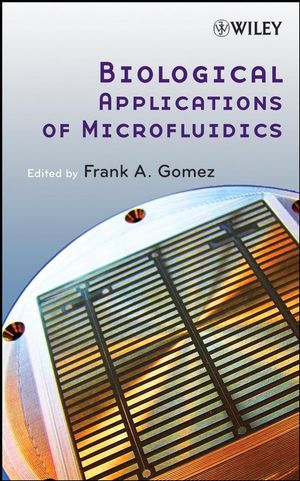Biological Applications of MicrofluidicsISBN: 978-0-470-07483-1
Hardcover
560 pages
February 2008
 This is a Print-on-Demand title. It will be printed specifically to fill your order. Please allow an additional 10-15 days delivery time. The book is not returnable.
|
||||||
Contributors.
1 Microfluidics.
1.1 Microfluidics.
PART I CELL ANALYSIS ON MICROFLUIDIC DEVICES.
2 Using Microfluidics to Understand and Control the Cellular Microenvironment.
2.1 Introduction: Engineering the Microenvironment.
2.2 The Chemical Microenvironment.
2.3 The Mechanical Microenvironment.
2.4 Conclusion.
3 Microfabricated Devices for Cell Sorting.
3.1 Introduction.
3.2 Microfabricated Formats for Cell Sorting.
3.3 Outlook for the Future.
4 Advanced Microfluidic Tools for Single-Cell Manipulation and Analysis.
4.1 Introduction.
4.2 Fluidic Control.
4.3 Temperature Control.
4.4 Cell Manipulation.
4.5 Detection.
4.6 Integration.
4.7 Conclusions.
5 Engineering Cellular Microenvironments with Microfluidics.
5.1 Introduction.
5.2 Microfluidic Cultures can Simulate in vivo Microenvironments.
5.3 Other Useful Capabilities of Microfluidic Cell Culture Devices.
5.4 Microfluidic Devices Useful for Cell Applications Other than Culture.
5.5 Future Prospects for Biological Studies in Microfluidic Bioreactors.
6 Microfluidic Culture Platforms for Stem Cell and Neuroscience Research.
6.1 Introduction.
6.2 Applications for Stem Cell Research.
6.3 Applications for Neuroscience Research.
6.4 Summary and Future Directions.
PART II ENZYMATIC AND NONENZYMATIC REACTIONS ON
MICROCHIPS.
7 Microfluidics for Studying Enzyme Inhibition.
7.1 Enzyme Assays and Inhibition.
7.2 Microfluidic Assays for Enzymes and Enzyme Inhibition.
7.3 Enzyme Inhibition Studies in Microfluidic Devices: Specific Studies.
8 Chemical Synthesis within Continuous Flow Microreactors.
8.1 Introduction.
8.2 Advantages of Performing Chemical Synthesis in Microreactors.
8.3 Chemical Synthesis in Microreactors.
8.4 Large-Scale Manufacture Using Microreactors.
8.5 Conclusions.
9 Microfluidic Reactors for Sequential and Parallel Reactions.
9.1 Introduction.
9.2 Sequential Reactions in Microfluidic Devices.
9.3 Parallel Reactions in Microfluidic Devices.
9.4 Conclusions.
10 Gene Isolation, Gene Transformation, and Enzyme Reaction on a Chip.
10.1 Introduction.
10.2 DNA/RNA Isolation on a Microfluidic Chip.
10.3 Gene Ligation on a Microfluidic Chip.
10.4 Gene Transformation on a Chip.
10.5 Enzymatic Reaction on a Chip.
10.6 Summary and Perspective.
PART III SEPARATIONS ON MICROCHIPS.
11 Chemical Monitoring in Complex Biological Environments Using Separation-Based Sensors in Chips.
11.1 Separation-Based Sensors.
11.2 Fast Separations with Separation-Based Sensors.
11.3 Micro Total Analysis Systems with Electrophoretic Separations for Monitoring of Biological Systems.
11.4 Miniaturization and Integration of Separation-Based Sensor Components.
12 Analytical Strategies Toward the Analysis of Phenolic
Compounds (Capillary Electrophoresis and Microchip
Capillary).
Electrophoresis.
12.1 Introduction.
12.2 Experimental Section.
12.3 Results and Discussion.
12.4 Applications.
12.5 Conclusions.
13 Chemical Separations in 3D Microfluidics.
13.1 Introduction.
13.2 Fabrication.
13.3 Results and Discussion on 3D Valves.
13.4 Microfluidic Three-Dimensional Separation Columns.
13.5 Results on Liquid Chromatography.
13.6 Conclusions.
14 Enabling Fundamental Research in Proteomics.
14.1 Introduction.
14.2 Membrane Protein Extraction.
14.3 Conclusion.
PART IV BIOMEDICAL APPLICATIONS OF MICROFLUIDICS.
15 Microengineering Neural Development.
15.1 Introduction.
15.2 Microengineering Guidance of Axons to their Targets.
15.3 Synaptogenesis on a Microfluidic Chip.
15.4 Conclusions.
16 Applications of Centrifugal Microfluidics in Biology.
16.1 Introduction.
16.2 Why Use Centrifugal Force for Fluid Manipulation?
16.3 How Centrifugal Microfluidic Platforms Work.
16.4 CD Applications.
16.5 Conclusions.
17 Microfluidic Techniques for Point-of-Care In Vitro Diagnostics.
17.1 Introduction.
17.2 Microfluidic Immunoassays.
17.3 Microfluidic Vias and Derivative Applications.
17.4 Conclusions.
PART V MICROFLUIDIC FABRICATION STUDIES.
18 Fabrication of Polymeric Microfluidic Devices.
18.1 Introduction.
18.2 Glass- and Silicon-Based Materials.
18.3 Plastics and Polymeric Materials.
18.4 Approaches to Microfabrication.
18.5 Selected Microfabrication Techniques.
18.6 Conclusions.
19 Nano Fountain Pen: Toward Integrated, Portable, Lab-on-Chip Devices.
19.1 Introduction.
19.2 Nano Fountain Pen.
19.3 Protein Printing.
19.4 Enzyme Lithography.
19.5 Polymer Microlenses.
19.6 Conclusions.
20 Surface Engineering of Microfluidic Devices Using Reactive Polymer Coatings.
20.1 Introduction.
20.2 Microfluidics Surface Modification Techniques.
20.3 Conclusions.
21 Microchips Containing In Situ Patterned Polymeric Media for Biochemical Analysis.
21.1 Introduction and Scope.
21.2 General Information about Patterned Materials.
21.3 Photopatterned Materials for Protein Analysis.
21.4 DNA Purification and Analysis.
21.5 Patterned Materials for Cell Culture and Analysis.
21.6 Other Biomolecules.
21.7 Conclusions.
PART VI HYBRID MICROFLUIDIC APPLICATIONS.
22 Coupling Electrochemistry to Microfluidics.
22.1 Introduction.
22.2 Electrochemical Methods of Analysis.
22.3 Microfluidic Devices.
22.4 Applications.
22.5 Conclusions and Future Directions.
23 Manipulating Mass-Limited Samples Using Hybrid Microfluidic/Nanofluidic Networks.
23.1 Introduction.
23.2 Nanofluidics.
23.3 Hybrid Microfluidic/Nanofluidic Systems.
23.4 Functionalized NCAMs.
23.5 The Future.
24 Magnetic Bead-based Methods to Study the Interaction of Teicoplanin with Peptides and Bacteria.
24.1 Introduction.
24.2 Experimental.
24.3 Results and Discussion.
24.4 Conclusions.
Acknowledgments.
25 Interfacing Microchannel Electrophoresis with Electrospray Ionization Mass Spectrometry.
25.1 Introduction.
25.2 Electrospray Ionization.
25.3 Coatings.
25.4 Spray Emitters.
25.5 CE and ESI Electrode Connections.
25.6 Integrated Applications.
25.7 Conclusions.
Index.



